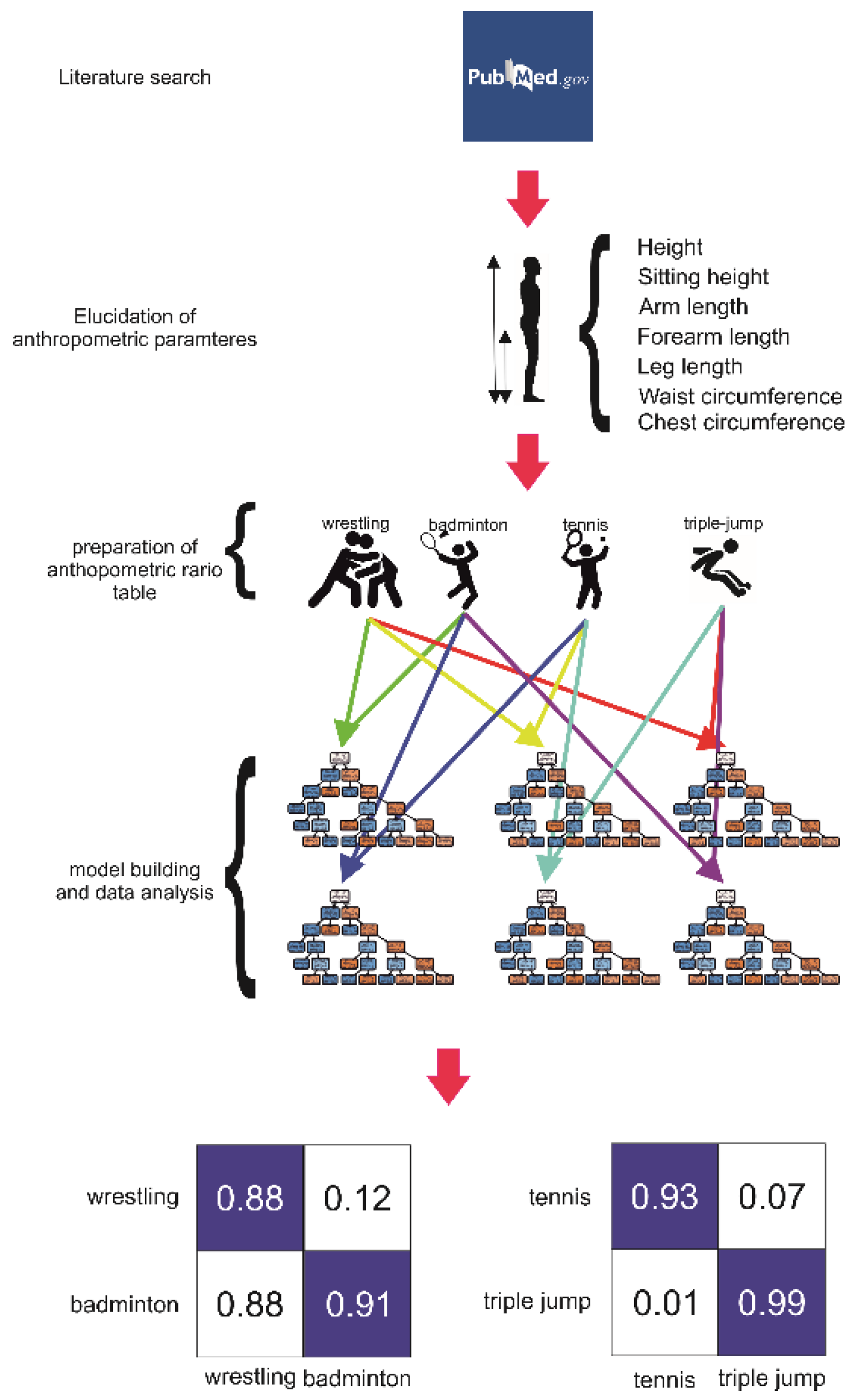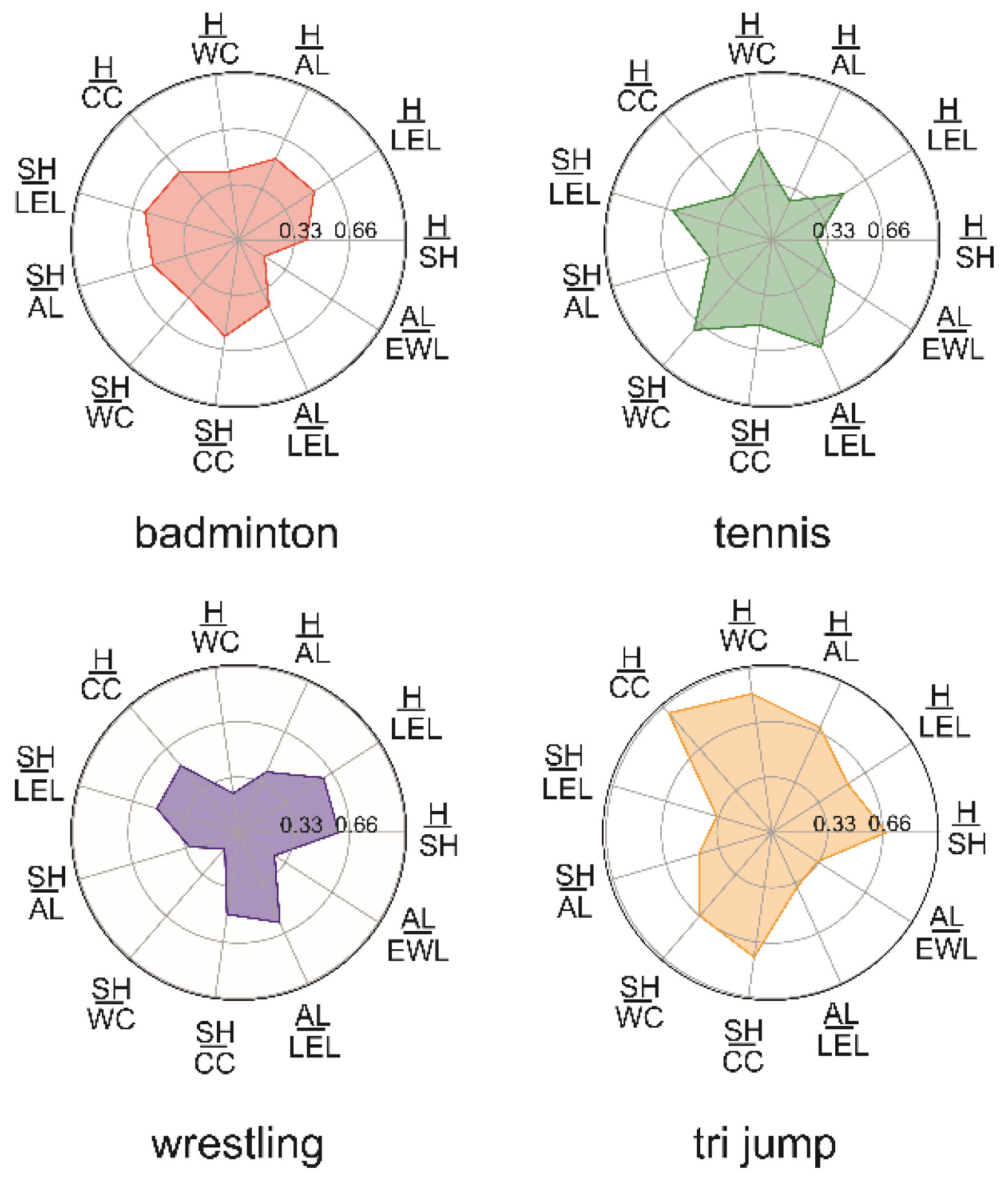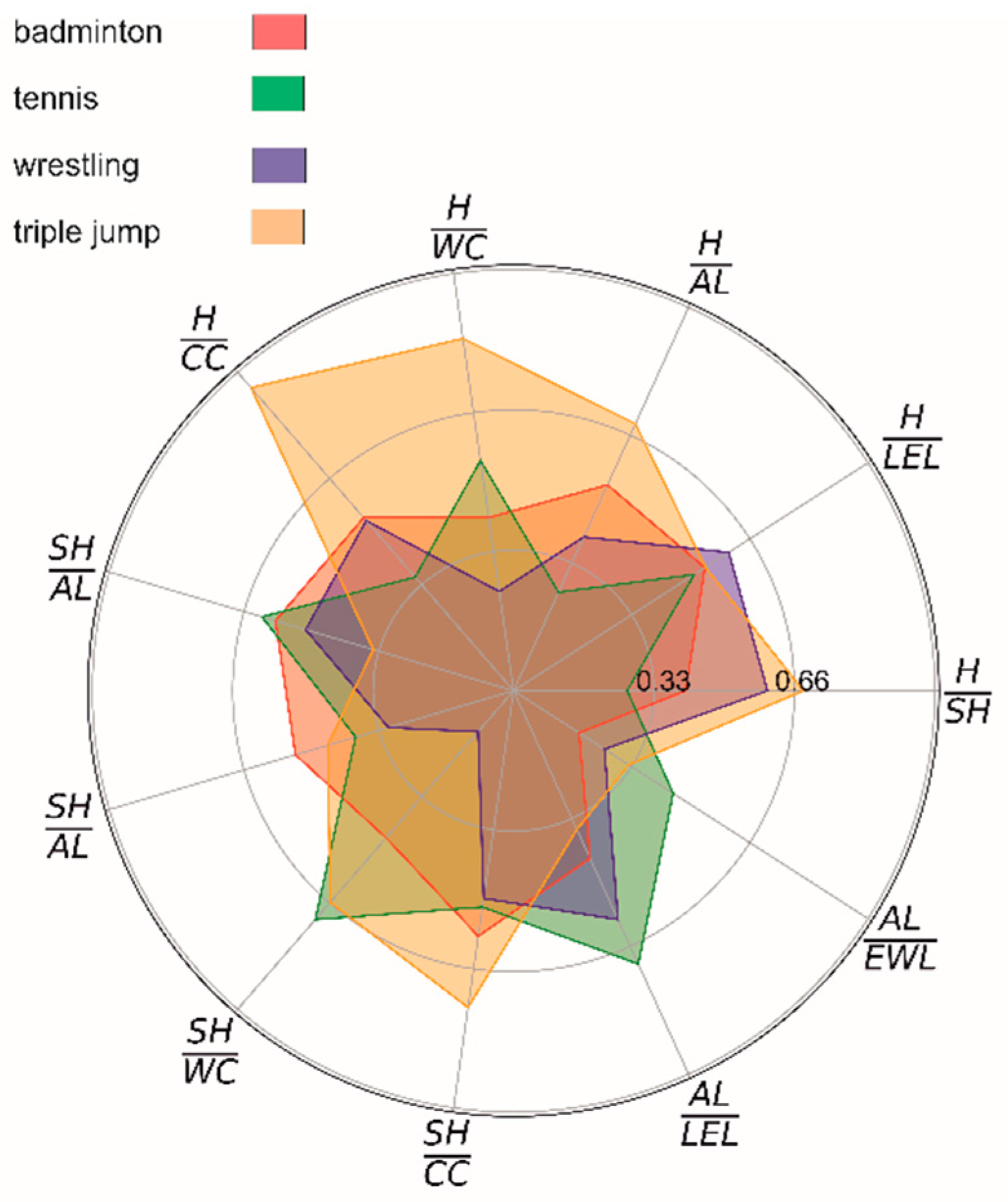Correlations between Anthropometric Measurements and Sports Discipline Aptitude
Abstract
:1. Introduction
2. Materials and Methods
3. Results
4. Discussion
5. Conclusions
Author Contributions
Funding
Informed Consent Statement
Data Availability Statement
Conflicts of Interest
References
- Jayanthi, N.; Pinkham, C.; Dugas, L.; Patrick, B.; Labella, C. Sports specialization in young athletes: Evidence-based recommendations. Sports Health 2013, 5, 251–257. [Google Scholar] [CrossRef] [PubMed] [Green Version]
- Cangur, S.; Yaman, C.; Ercan, I.; Yaman, M.; Tok, S. The relationship of anthropometric measurements with psychological criteria in female athletes. Psychol. Health Med. 2017, 22, 325–331. [Google Scholar] [CrossRef]
- Faber, M.; Benade, A.J.; van Eck, M. Dietary intake, anthropometric measurements, and blood lipid values in weight training athletes (body builders). Int. J. Sports Med. 1986, 7, 342–346. [Google Scholar] [CrossRef] [PubMed]
- Faber, M.; Spinnler-Benade, A.J.; Daubitzer, A. Dietary intake, anthropometric measurements and plasma lipid levels in throwing field athletes. Int. J. Sports Med. 1990, 11, 140–145. [Google Scholar] [CrossRef] [PubMed]
- Hencken, C.; White, C. Anthropometric assessment of Premiership soccer players in relation to playing position. Eur. J. Sport Sci. 2006, 6, 205–211. [Google Scholar] [CrossRef]
- Kaplan, D.Ö.; Yıldıran, İ. Comparison of Somatotype Characteristics and Anthropometric Proportional Relations of Elite Wrestlers between Styles and Weights. J. Educ. Train. Stud. 2018, 6, 10. [Google Scholar] [CrossRef] [Green Version]
- Massarani, F.A.; Canella, D.S.; Brito, F.B.; Citelli, M.; Koury, J.C. Assessment of trends of nutritional status, central obesity, and growth profile using anthropometric measurements in adolescent athletes from a sport-oriented public school. J. Sports Med. Phys. Fit. 2019, 59, 1885–1891. [Google Scholar] [CrossRef]
- Montoye, H.J.; E Howard, G.; Wood, J.H. Observations of some hemochemical and anthropometric measurements in athletes. J. Sports Med. Phys. Fit. 1967, 7, 35–44. [Google Scholar]
- Neogi, A.; Tiwari, A.; Medabala, T.; Adhikari, S.; Dey, S.K. Somatotype, Body Composition and Anthropometric Profiles of Indian Male Greco-Roman Wrestlers. Int. J. Sport Stud. Health 2019, 2, e93102. [Google Scholar] [CrossRef]
- Noh, J.-W.; Kim, J.-H.; Kim, J. Somatotype analysis of freestyle wrestlers compared with nonathletes for health science research. Toxicol. Environ. Health Sci. 2014, 6, 244–250. [Google Scholar] [CrossRef]
- Pineau, J.C.; Bouslah, M. Prediction of body fat in male athletes from ultrasound and anthropometric measurements versus DXA. J. Sports Med. Phys. Fit. 2020, 60, 251–256. [Google Scholar] [CrossRef] [PubMed]
- Radu, L.-E.; Hazar, F.; Puni, A.-R. Anthropometric and Physical Fitness Characteristics of University Students. Proc. Soc. Behav. Sci. 2014, 149, 798–802. [Google Scholar] [CrossRef] [Green Version]
- Raschka, C.; Schmidt, K. Sports anthropological and somatotypical comparison between higher class male and female badminton and tennis players. Pap. Anthropol. 2013, 22, 153. [Google Scholar] [CrossRef] [Green Version]
- Santos, D.A.; Dawson, J.A.; Matias, C.N.; Rocha, P.M.; Minderico, C.S.; Allison, D.B.; Sardinha, L.B.; Silva, A.M. Reference values for body composition and anthropometric measurements in athletes. PLoS ONE 2014, 9, e97846. [Google Scholar] [CrossRef] [Green Version]
- Sterkowicz-Przybycien, K.L.; Sterkowicz, S.; Zarow, R.T. Somatotype, body composition and proportionality in polish top greco-roman wrestlers. J. Hum. Kinet. 2011, 28, 141–154. [Google Scholar] [CrossRef]
- Nudri, W.W.; Ismail, M.; Zawiak, H. Anthropometric measurements and body composition of selected national athletes. Malays. J. Nutr. 1996, 2, 138–147. [Google Scholar]
- Singh, K. Anthropometric Measurements, Body Composition and Somatotyping among University Level High and Low Performer Triple Jumpers. Int. J. Cur. Res. Rev. 2017, 9, 44–47. [Google Scholar]
- Singh, S.; Singh, K.; Singh, M. Anthropometric measurements, body composition and somatotyping of high jumpers. Braz. J. Biomotricity 2010, 4, 266–271. [Google Scholar]
- Smaruj, M.; Orkwiszewska, A.; Adam, M.; Jeżyk, D.; Kostrzewa, M.; Laskowski, R. Changes in Anthropometric Traits and Body Composition over a Four-Year Period in Elite Female Judoka Athletes. J. Hum. Kinet. 2019, 70, 145. [Google Scholar] [CrossRef] [Green Version]
- Heydenreich, J.; Kayser, B.; Schutz, Y.; Melzer, K. Total Energy Expenditure, Energy Intake, and Body Composition in Endurance Athletes across the Training Season: A Systematic Review. Sports Med. Open 2017, 3, 8. [Google Scholar] [CrossRef] [Green Version]
- Hastie, T.; Tibshirani, R.; Friedman, J.H. The Elements of Statistical Learning. In Data Mining, Inference, and Prediction, 2nd ed.; Springer: New York, NY, USA, 2009; 745p. [Google Scholar]
- Buntine, W. Learning Classification Trees. Stat. Comput. 1995, 2, 63–73. [Google Scholar] [CrossRef] [Green Version]
- Tan, P.-N.; Steinbach, M.; Karpatne, A.; Kumar, V. Introduction to Data Mining, 2nd ed.; Pearson: New York, NY, USA, 2019; 839p. [Google Scholar]
- Fürnkranz, J. Decision Tree. In Encyclopedia of Machine Learning; Sammut, C., Webb, G.I., Eds.; Springer: Boston, MA, USA, 2010; pp. 263–267. [Google Scholar]
- Daniya, T.; Geetha, M.; Kumar, K.S. Classification and Regression Trees with Gini Index. Adv. Math. Sci. J. 2020, 9, 1857–8438. [Google Scholar] [CrossRef]
- Di Credico, A.; Gaggi, G.; Ghinassi, B.; Mascherini, G.; Petri, C.; Di Giminiani, R.; Di Baldassarre, A.; Izzicupo, P. The Influence of Maturity Status on Anthropometric Profile and Body Composition of Youth Goalkeepers. Int. J. Environ. Res. Public Health 2020, 17, 8247. [Google Scholar] [CrossRef] [PubMed]
- Lesinski, M.; Schmelcher, A.; Herz, M.; Puta, C.; Gabriel, H.; Arampatzis, A.; Laube, G.; Büsch, D.; Granacher, U. Maturation-, age-, and sex-specific anthropometric and physical fitness percentiles of German elite young athletes. PLoS ONE 2020, 15, e0237423. [Google Scholar] [CrossRef]
- Veldre, G.; Jurimae, T. Anthropometric parameters and sexual maturation in 12- to 15-year-old Estonian boys. Anthr. Anz. 2004, 62, 203–215. [Google Scholar] [CrossRef]
- Bonato, M.; Maggioni, M.; Rossi, C.; Rampichini, S.; La Torre, A.; Merati, G. Relationship between anthropometric or functional characteristics and maximal serve velocity in professional tennis players. J. Sports Med. Phys. Fit. 2014, 55, 1157–1165. [Google Scholar]
- Elce, A.; Cardillo, G.; Ventriglia, M.; Giordano, C.; Amirante, F.; Mazza, G.; Sangiorgio, A.; Martiniello, L. Anthropometric characteristics of young Italian tennis players. J. Hum. Sport Exerc. 2017, 12, 651–658. [Google Scholar] [CrossRef] [Green Version]
- Miftari, F.; Jarani, J.; Stratoberdha, D.; Salihu, H. A Comparison of The Anthropometric Parameters between Basketball Players, Handball Players and Volleyball Players. Eur. J. Phys. Educ. Sport Sci. 2017, 3, 155–164. [Google Scholar] [CrossRef]
- Fatahi, A.; Ameli, M.; Sadeghi, H.; Mahmoodi, B. Relationship between anthropometric parameters with vertical jump in male elite volleyball players due to game’s position. J. Hum. Sport Exerc. 2012, 7, 714–726. [Google Scholar] [CrossRef] [Green Version]





| Code | Triple Jump [21] | Wrestling [6] | Tennis [13] | Badminton [13] | ||||
|---|---|---|---|---|---|---|---|---|
| Mean | SD | Mean | SD | Mean | SD | Mean | SD | |
| H | 180 | 2.7 | 171 | 8.7 | 185 | 4.8 | 182 | 4.6 |
| SH | 91 | 1.3 | 92 | 4.2 | 96 | 3.2 | 96 | 2.5 |
| WC | 78 | 1.6 | 84 | 10.5 | 80 | 4 | 82 | 3.8 |
| CC | 94 | 1.8 | 105 | 10.7 | 96 | 5.2 | 96 | 4.3 |
| LEL | 102 | 1.5 | 102 | 7 | 104 | 4.2 | 102 | 3.5 |
| AL | 80 | 1.2 | 75 | 4.4 | 82 | 5.4 | 80 | 4.4 |
| EWL | 26 | 0.4 | 26 | 1.8 | 26 | 6 | 27 | 4.1 |
| H/SH | H/LEL | H/AL | H/WC | H/CC | SH/LEL | SH/AL | SH/WC | SH/CC | AL/LEL | AL/EWL | |
|---|---|---|---|---|---|---|---|---|---|---|---|
| badminton | 1.90 ± 0.058 | 1.79 ± 0.064 | 2.29 ± 0.126 | 2.24 ± 0.104 | 1.90 ± 0.082 | 0.943 ± 0.035 | 1.20 ± 0.064 | 1.18 ± 0.056 | 1.00 ± 0.046 | 0.78 ± 0.044 | 3.01 ± 0.443 |
| tennis | 1.93 ± 0.07 | 1.77 ± 0.073 | 2.26 ± 0.14 | 2.32 ± 0.116 | 1.94 ± 0.102 | 0.92 ± 0.041 | 1.17 ± 0.073 | 1.20 ± 0.063 | 1.00 ± 0.057 | 0.79 ± 0.052 | 3.26 ± 0.738 |
| triple jump | 1.99 ± 0.037 | 1.78 ± 0.034 | 2.26 ± 0.04 | 2.30 ± 0.052 | 1.93 ± 0.04 | 0.89 ± 0.016 | 1.14 ± 0.02 | 1.16 ± 0.025 | 0.97 ± 0.02 | 0.79 ± 0.014 | 3.03 ± 0.053 |
| wrestling | 1.86 ± 0.117 | 1.69 ± 0.128 | 2.28 ± 0.157 | 2.07 ± 0.244 | 1.65 ± 0.163 | 0.90 ± 0.064 | 1.23 ± 0.078 | 1.12 ± 0.132 | 0.89 ± 0.086 | 0.74 ± 0.059 | 2.86 ± 0.223 |
| Wrestling | Badminton | Tennis | |
|---|---|---|---|
| badminton | 0.949 | ||
| tennis | 0.951 | 0.756 | |
| triple jump | 0.992 | 0.975 | 0.979 |
Publisher’s Note: MDPI stays neutral with regard to jurisdictional claims in published maps and institutional affiliations. |
© 2022 by the authors. Licensee MDPI, Basel, Switzerland. This article is an open access article distributed under the terms and conditions of the Creative Commons Attribution (CC BY) license (https://creativecommons.org/licenses/by/4.0/).
Share and Cite
Wiacek, M.; Tomasiuk, R.; Zubrzycki, I.Z. Correlations between Anthropometric Measurements and Sports Discipline Aptitude. Appl. Sci. 2022, 12, 5932. https://doi.org/10.3390/app12125932
Wiacek M, Tomasiuk R, Zubrzycki IZ. Correlations between Anthropometric Measurements and Sports Discipline Aptitude. Applied Sciences. 2022; 12(12):5932. https://doi.org/10.3390/app12125932
Chicago/Turabian StyleWiacek, Magdalena, Ryszard Tomasiuk, and Igor Z. Zubrzycki. 2022. "Correlations between Anthropometric Measurements and Sports Discipline Aptitude" Applied Sciences 12, no. 12: 5932. https://doi.org/10.3390/app12125932
APA StyleWiacek, M., Tomasiuk, R., & Zubrzycki, I. Z. (2022). Correlations between Anthropometric Measurements and Sports Discipline Aptitude. Applied Sciences, 12(12), 5932. https://doi.org/10.3390/app12125932





